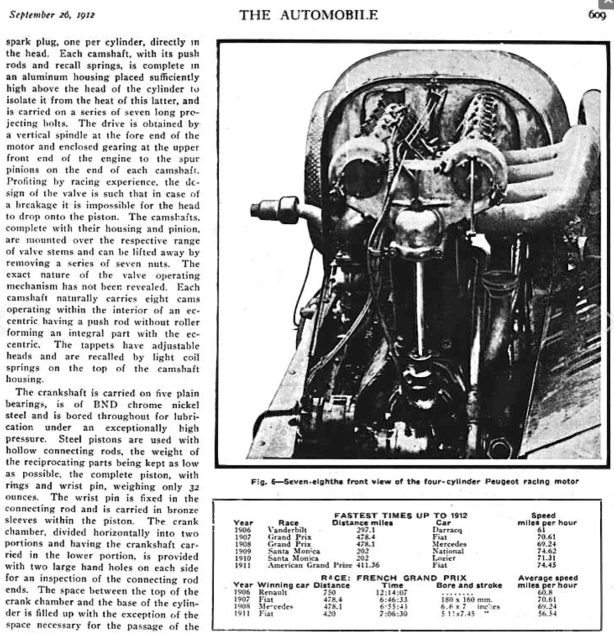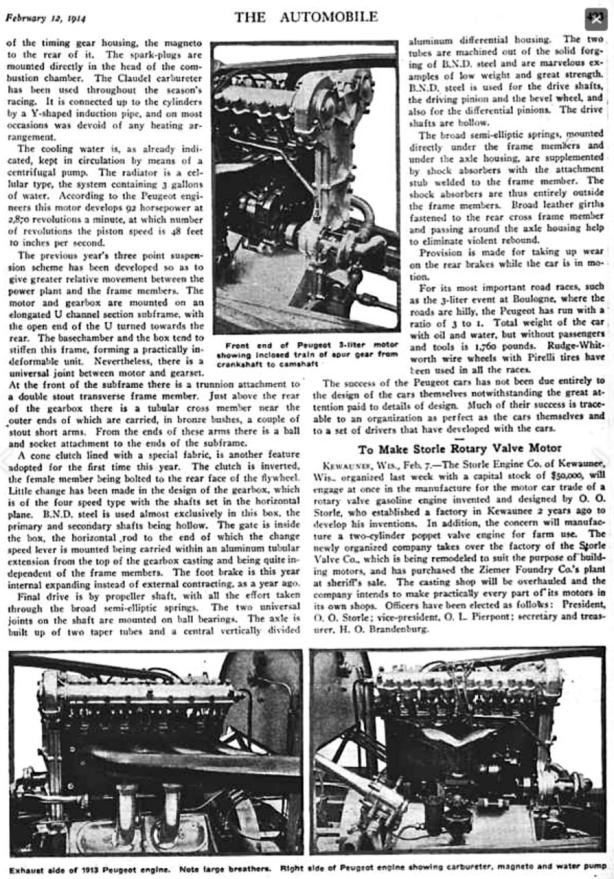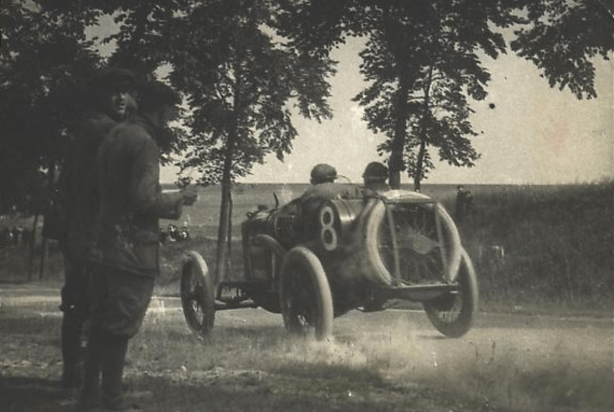‘One of the most classic racing engines of all time – and unquestionably the most widely copied – was the 1913 3-litre four cylinder Peugeot conceived jointly by Georges Boillot, Jules Goux and Paolo Zuccarelli whose ideas were interpreted by the brilliant draftsman Ernest Henry’ ; Harry Mundy in Automobile Year #10…
The team first expounded the advantages of twin overhead camshafts, four valves per cylinder and compact combustion chambers.
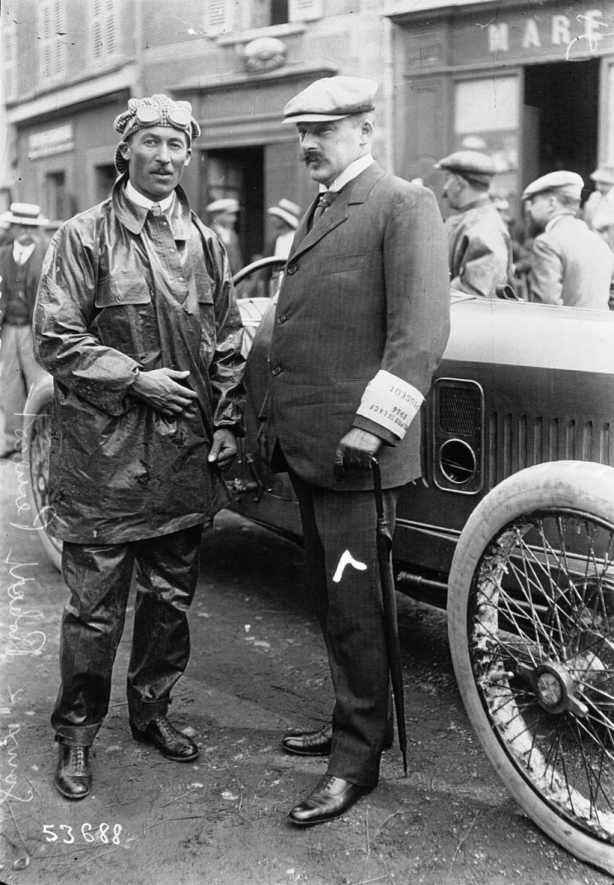
Jules Goux fourth and Robert Peugeot at the 1914 French GP. Goux winner at Indy in 1913 in a Peugeot L56. Mercedes Christian Lautenschlager won the race, Boillot was well in the lead before a spate of Dunlop tyre problems. 4 July 1914, less than a week after the assassination of Archduke Franz Ferdinand and the imminent start of WW1 (unattributed)
‘The Three Charlatans’; driver/technicians Goux, Boillot and Zuccarelli, the latter the most important in terms of his conceptual ideas, as they became known within Peugeot HQ, put a proposal to M Robert Peugeot to develop, outside the factory a team of cars for the 1912 French GP. The race was being revived that year, and two 3-litre cars for the Coup l’Auto at a cost of 4000 pounds for each car.
The 1912 GP engine of 7602cc was estimated to develop 140bhp@2200rpm, the car very successful as covered in the contemporary magazine articles included at the end of this piece.
‘Overhead camshafts had been used earlier by Mercedes and Clement-Bayard…The technical contribution of the Peugeot engine was in the use of the hemispherical combustion chamber, four valves per cylinder operated directly by twin overhead camshafts and a central sparking plug. In other words, Zuccarelli, from whom this conception emanated, appreciated the virtues of a compact combustion chamber, large effective valve area and low valve stresses’.
‘A stirrup-type valve tappet guided top and bottom ad having its own return spring was used and the entire mechanism was fully enclosed and lubricated; the valves and springs were exposed to assist cooling…The one piece cylinder block and head was bolted to a two piece crankcase split on the horizontal centre line of the five main bearings’ said Mundy.
Boillot won the 1912 French GP at Dieppe by 13 minutes from the closest Fiat at an average speed of 68.5 mph. The Fiats, to demonstrate the efficiency of the Peugeot engine were of 14143cc.
The 3-litre Peugeot engine produced for the 1913 Coupe de l’Auto race run concurrently with the French GP, was the more important in its technical influence as its efficiency and light chassis was more than a match for the 1912/13 GP cars built for an unlimited formula and having in some cases twice the capacity.
Many features of the 3-litre were common with its bigger brother but other key elements copiously copied were;
.A train of spur gears contained in a separate and easily detachable casing which replaced the former bevel gear and shaft drive to the camshafts
.The heavy stirrup type of valve tappet was discarded in favour of a finger interposed between the cam and valve stem
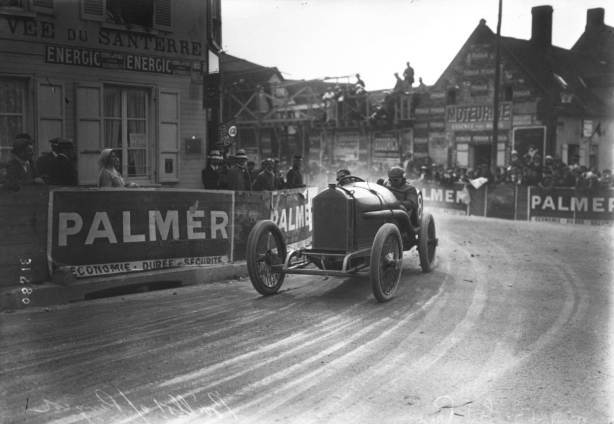
Boillot on the way to Peugeot L3 victory on the Amiens 31.6 km road course used only once for the French GP, in 1913. Zuccarelli was killed when he hit a cart before the race; five fatalities at the place in two months (unattributed)
.A novel construction was introduced for the crankcase and the three main bearing crank, made of the highest quality BND/Derihon steel. The latter was made in two halves and bolted at the centre, at which point a double row ball bearing was used; a single row roller bearing was used for the front and rear mains. This type of construction permitted the use of a one-piece crankcase casting, the two end bearings for the crankshaft being contained in a separate housing.
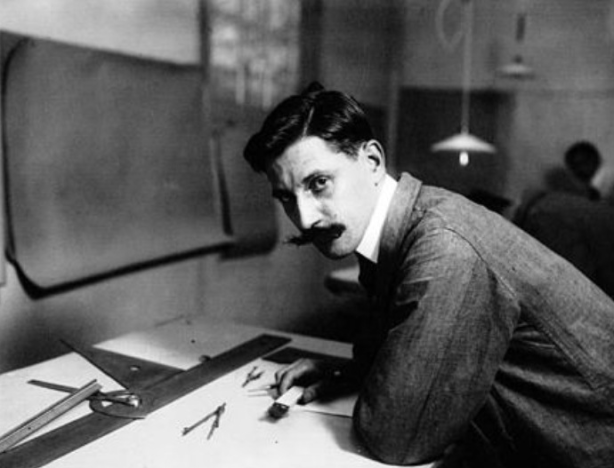
Ernest Henry at his drawing board, year unknown. Hiss exact contribution to the design of the Peugeot’s and the engine still the subject of debate after 100 years; a key member of the team whichever way you cut it (unattributed)
.It was also the first engine to use dry-sump lubrication; better cooling with full pressurisation to all bearings and also allowing engines to be placed lower in the chassis.
The influence of the engine was also profound in the sense that it lead to the adoption of a capacity limitation from 1914, a principle adopted for most subsequent formulae. From 1914 onwards there was no effective alternative to the overhead camshaft as stroke to bore ratios were reduced and rotational speeds increased, two basic requirements of increased performance…
Contemporary ‘The Automobile’ articles on the 1912/1913 Peugeots…
1912 L76 7.6-litre.
1913 L3 3-litre.
Bibliography and Credits…
Automobile Year #10 article by Harry Mundy on Grand Prix engines, ‘The Automobile’ 26 September 1912 and February 1914 articles via theoldmotor.com, The Nostalgia Forum Peugeot GP thread, Jacques Henri-Lartigue
Tailpiece: Boillot, winner on Peugeot L3. French GP, Amiens 12 July 1913…
Finito…





